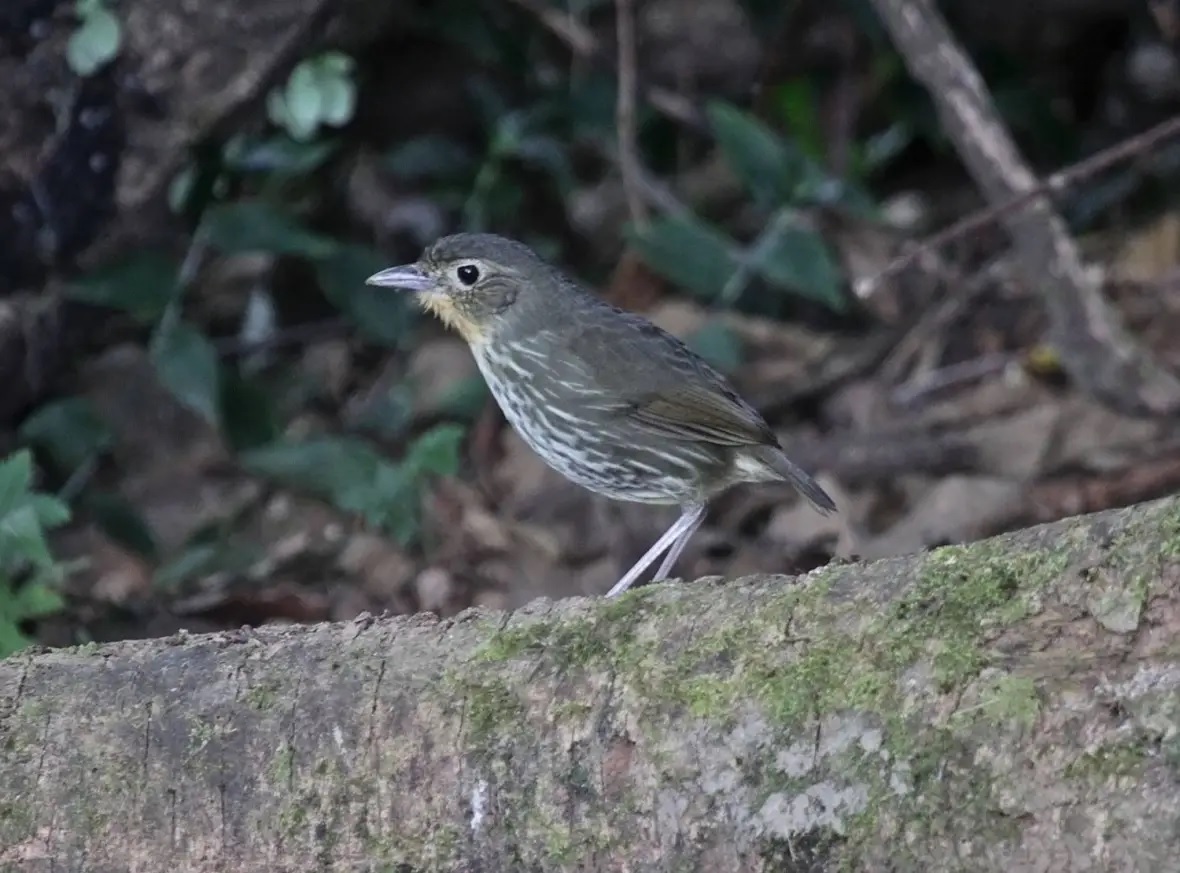Order: PASSERIFORMES
Family: GRALLARIDAE
This species is endemic to the Sierra Nevada de Santa Marta in Colombia and is probably closely related to G. kaestneri. Its name Grallaria derives from the modern Latin grallarius = stiltwalker and its epithet Bangsi was established in honor of the American zoologist and collector Outram Bangs.
Description
It is about 18 cm in lenght. The weight of an unsexed bird is known (62 g). Both sexes similar. It has brown irises, leaden gray tarsi and a bill with a black upper jaw and a leaden blue lower jaw. Above it is olive brown with an olive-greyish crown, it has a whitish point in the loreal region, brown ear-coverts and a whitish eye ring. Its throat is bright okra buff with indistinguishable white streaks, the rest of the underparts white with dark streaks, and olive-brown flanks with white streaks.
Similar species
In its range, the only species of the genus with which it could overlap and be confused is the Scaled Antpitta (Grallaria guatimalensis) which has blackish scaly upper parts, buffy whiskers and dark underparts, not white with dark stripes.
Regional Differences
It is considered a monotypic species.
Distribution
It is found in the north of Colombia. This species is endemic to the Sierra Nevada de Santa Marta where it is distributed from 1200 to 2400 m above sea level.
Habitat
It inhabits mature humid forests and forests in advanced secondary succession, where it uses the soil and the low understory. Sometimes it also uses forest edges and small clearings.
Reproduction
In the month of September, a female was registered in reproductive condition, also a young one following an adult in the month of July and an immature one was collected in May. Other aspects of their reproductive biology remain undocumented.
Behavior
It moves mainly on the ground and low branches. When perishing it is less elusive than its congeners so it can be easier to see. It feeds in clearings and edges, mainly in the morning hours.
Conservation status
At the national and international level, it is classified as a species in a Vulnerable state. The main threats it faces are the destruction and fragmentation of its habitat, due to the expansion of the agricultural boundary, indiscriminate logging, burning and the establishment of illicit crops. The expansion of illicit crops, in turn, has resulted in herbicide spraying by the state, with a consequent degradation of the ecosystem. It is estimated that this species has lost about 50% of its habitat
Conservation actions
Private natural reserves have been established that have helped to reduce the pressure on this species a bit and it is highlighted that the upper part of the San Pedro district where an individual was observed is protected by the indigenous reservation and the PNN SNSM (C Navarro pers. Comm. 2010). Additionally, the species has been registered in 3 areas declared as AICA, it is also in the PNN SNSM and the conservation actions carried out in the RN La Cumbre stand out, where it is common to find the species.
Vocalization/ song
https://www.xeno-canto.org/444971
References
Avibase 2017. Grallaria alleni. Downloaded from http://avibase.bsc-eoc.org/species.jsp?lang=ES&avibaseid=66435A66F65F3643
BirdLife International. 2017. Grallaria alleni. The IUCN Red List of Threatened Species 2017: e.T22703252A93912650. Downloaded on 16 February 2017.
Hilty, S. L. and W. L. Brown. 2001. Guide to the Birds of Colombia. Princetn. Univ. Press, Princeton, NJ.
Jobling, C. 2010. The Helm dictionary of scientific birds names. Christopher Helm and A & C Black Publishers Ltda. London.
Remsen, J. V., Jr., C. D. Cadena, A. Jaramillo, M. Nores, J. F. Pacheco, J. Pérez-Emán, M. B. Robbins, F. G. Stiles, D. F. Stotz, and K. J. Zimmer. Version September 26, 2016. A classification of the bird species of South America. American Ornithologists’ Union.http: //www.museum.lsu.edu/~Remsen/SACCBaseline.html.









